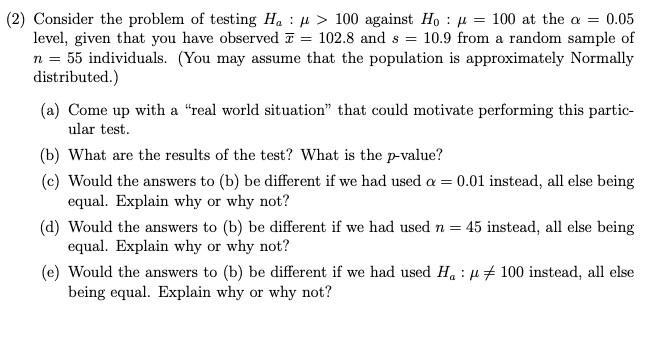(2) Consider the problem of testing H. : µ > 100 against Ho : µ = 100 at the a = 0.05 level, given that you have observed 7 = 102.8 and s = 10.9 from a random sample of n = 55 individuals. (You may assume that the population is approximately Normally distributed.) (a) Come up with a “real world situation" that could motivate performing this partic- ular test. (b) What are the results of the test? What is the p-value? (c) Would the answers to (b) be different if we had used a = 0.01 instead, all else being equal. Explain why or why not? (d) Would the answers to (b) be different if we had used n = 45 instead, all else being equal. Explain why or why not? (e) Would the answers to (b) be different if we had used H. : µ # 100 instead, all else being equal. Explain why or why not?
(2) Consider the problem of testing H. : µ > 100 against Ho : µ = 100 at the a = 0.05 level, given that you have observed 7 = 102.8 and s = 10.9 from a random sample of n = 55 individuals. (You may assume that the population is approximately Normally distributed.) (a) Come up with a “real world situation" that could motivate performing this partic- ular test. (b) What are the results of the test? What is the p-value? (c) Would the answers to (b) be different if we had used a = 0.01 instead, all else being equal. Explain why or why not? (d) Would the answers to (b) be different if we had used n = 45 instead, all else being equal. Explain why or why not? (e) Would the answers to (b) be different if we had used H. : µ # 100 instead, all else being equal. Explain why or why not?
MATLAB: An Introduction with Applications
6th Edition
ISBN:9781119256830
Author:Amos Gilat
Publisher:Amos Gilat
Chapter1: Starting With Matlab
Section: Chapter Questions
Problem 1P
Related questions
Question
c,d,e

Transcribed Image Text:(2) Consider the problem of testing Ha : µ > 100 against Ho : µ = 100 at the a = 0.05
level, given that you have observed 7
n = 55 individuals. (You may assume that the population is approximately Normally
distributed.)
102.8 and s =
10.9 from a random sample of
%3D
(a) Come up with a “real world situation" that could motivate performing this partic-
ular test.
(b) What are the results of the test? What is the p-value?
(c) Would the answers to (b) be different if we had used a = 0.01 instead, all else being
equal. Explain why or why not?
(d) Would the answers to (b) be different if we had used n =
equal. Explain why or why not?
45 instead, all else being
(e) Would the answers to (b) be different if we had used H. : µ# 100 instead, all else
being equal. Explain why or why not?
Expert Solution
This question has been solved!
Explore an expertly crafted, step-by-step solution for a thorough understanding of key concepts.
Step by step
Solved in 2 steps

Recommended textbooks for you

MATLAB: An Introduction with Applications
Statistics
ISBN:
9781119256830
Author:
Amos Gilat
Publisher:
John Wiley & Sons Inc

Probability and Statistics for Engineering and th…
Statistics
ISBN:
9781305251809
Author:
Jay L. Devore
Publisher:
Cengage Learning

Statistics for The Behavioral Sciences (MindTap C…
Statistics
ISBN:
9781305504912
Author:
Frederick J Gravetter, Larry B. Wallnau
Publisher:
Cengage Learning

MATLAB: An Introduction with Applications
Statistics
ISBN:
9781119256830
Author:
Amos Gilat
Publisher:
John Wiley & Sons Inc

Probability and Statistics for Engineering and th…
Statistics
ISBN:
9781305251809
Author:
Jay L. Devore
Publisher:
Cengage Learning

Statistics for The Behavioral Sciences (MindTap C…
Statistics
ISBN:
9781305504912
Author:
Frederick J Gravetter, Larry B. Wallnau
Publisher:
Cengage Learning

Elementary Statistics: Picturing the World (7th E…
Statistics
ISBN:
9780134683416
Author:
Ron Larson, Betsy Farber
Publisher:
PEARSON

The Basic Practice of Statistics
Statistics
ISBN:
9781319042578
Author:
David S. Moore, William I. Notz, Michael A. Fligner
Publisher:
W. H. Freeman

Introduction to the Practice of Statistics
Statistics
ISBN:
9781319013387
Author:
David S. Moore, George P. McCabe, Bruce A. Craig
Publisher:
W. H. Freeman